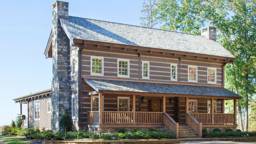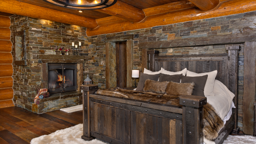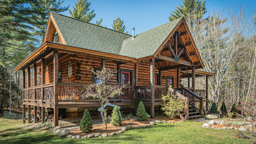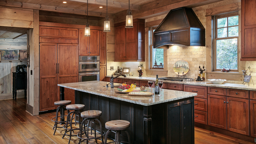
Make sure the design you select matches the location on which you plan to build. Credit: © Dmitry Pichugin - Fotolia.com
Mountains
DesignIn mountain environments, it's all about the view. When people build on land that "slopes aggressively down toward that view, they often don't realize their foundation costs can rise exponentially," warns log home architect Rand Soellner, of Cashiers, North Carolina, an area famous for its mountain terrain. A long and narrow floorplan can keep those expenses down. "The foundation materials will cost less, and you'll have more of the rooms facing the views for you to enjoy." Consider how to site the house with prevailing winds, suggests Dianne Collins, construction advisor at Real Log Homes in Hartland, Vermont. "You'll want to place your windows on the south side to maximize passive solar gain. Keep windows on the north side to as few as possible since it will receive little sun." Think mountains, and snow comes to mind. A steep-pitched, standing-seam metal roof encourages snow to slide off and prevents ice dams and drainage issues. Properly designed overhangs and well-draining roofs are critical in keeping water off the log walls.
Log Species
Log species isn't a major consideration when building in a mountainous region. Doug Mikkelsen, president of Old Style Log Works in Kalispell, Montana, prefers using species native to the area, but says engineering is more important than timber type. "I stress the design no matter what," he says. Plan on a maintenance program using a preservative that allows logs to breathe.
Lakefront
DesignFor most people building near a lake, priority number one is orienting the home — specifically, the windows — to capture the best possible views of the water. But there are a few design considerations you'll have to keep in mind. For example, what's the wind load on a large, heavily windowed wall? And how will it impact the structure? "Quality glazing and proper engineering will ensure wind-exposed walls are stable," Dianne says. Double glazing insulates almost twice as well as single glazing.
Log Species
Designer Brian Delwiche of Wisconsin Log Homes in Green Bay recommends cedar and pine as good log choices for waterfront areas due to their resistance to decay, mold, mildew and dry rot.
Ask your log manufacturer about stains and finishes that are specifically designed to protect the logs from sun exposure and water damage.
Ask your log manufacturer about stains and finishes that are specifically designed to protect the logs from sun exposure and water damage.
Desert
DesignDry, sun-filled environments can wreak havoc on logs. The sun's ultraviolet rays can cause them to fade, dry out and settle more than they would in other regions. If your heart's set on a log home in the Southwest, these facts are no reason to give up your dream. There are ways to design your home to combat nature. "Look to limit solar exposure on the house," says Real Log Homes' Dianne Collins. "Windows positioned on the south side (that reflect heat away from the home) and longer overhangs will keep harsh UV rays off walls. Site the house to take advantage of natural or manmade hills or berms so you can buffer the home against extreme temperature changes by tucking it into its environment."
Log Species
No question about it: The desert is a harsh climate for wood. In these kind of conditions, Doug Mikkelsen prefers cedar. "With this wood species, there's not as much log degradation because of the drier climate," he says. In general, the denser the species, the better, according to architect Rand Soellner (who's worked on projects in Kuwait City). "It's extremely important to have a preventive maintenance program," he notes. "Inspect the logs every year and, to protect the wood fibers from the sun's harsh rays, re-coat them more frequently than you would in other environments." Lower-pitched roofs combined with sun-protecting overhangs can help. Rand recommends high-end, fiberglass shingles, copper metal, slate or a synthetic slate made from recycled materials.
Praries
DesignWith beating summer sun and howling winter winds, prairies are notorious for extremes. Experts say low-rise ranch-style homes are a popular design choice for the way they contour to the land and blend in with the environment. "In order to have a certain amount of presence, the scale of the home has to be a little bit larger," says designer Jason Cytacki with BK Cypress Log Homes in Bronson, Florida. The views are also important, but the mistake many people make is building on the most beautiful spot on the property. "You want to build facing that beautiful spot so you can enjoy it, not destroy it," he says. "In a prairie with a vast amount of open space around you, it's easy for the home to become overpowered by the roofline," Jason says. For that reason, it's important to increase the log wall heights to a height-width ratio that matches the roofline." Lower roof slopes will help keep heating costs down in winter.
Log Species
When it comes to species, everyone has a favorite. Rand likes the strength of Douglas fir. Designer Brian Delwiche puts cedar at the top of his list. "Red cedar is one of my favorite species to work with, followed by northern white pine. They're both resistant to decay, and they take a finish well." Cypress is Jason's first choice. "There's less shrinkage than with some other species," he explains. No matter if you're building on a grassy plain, at water's edge, on the top of a mountain or on the desert floor, industry insiders stress what might be the most valuable consideration: aesthetics. Advanced building materials and innovative engineering allow for preferences to play a dominant role in the design process, and regardless of terrain, there should be no place like home.





_11868_2023-12-20_08-12-256x288.jpg)





